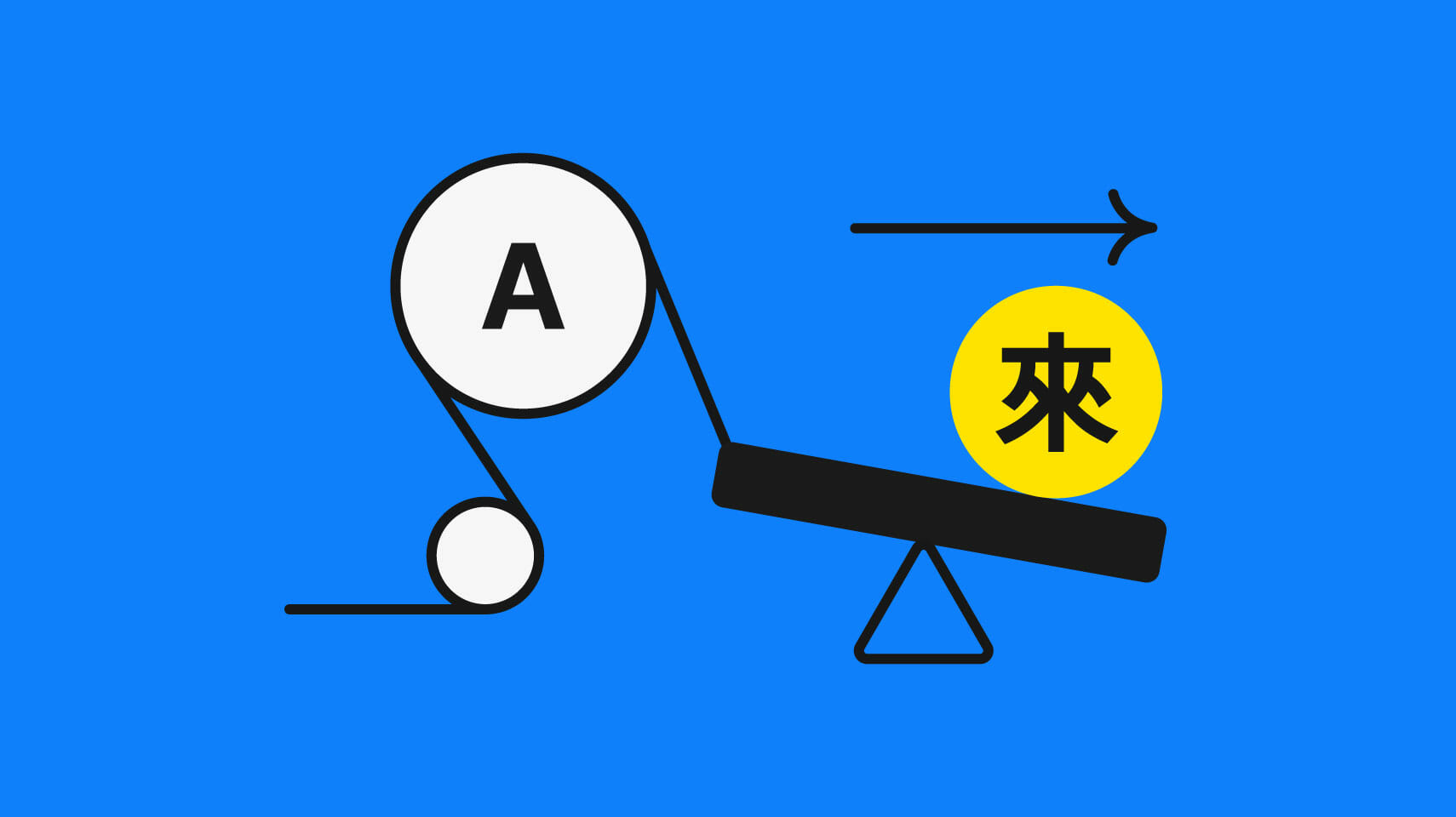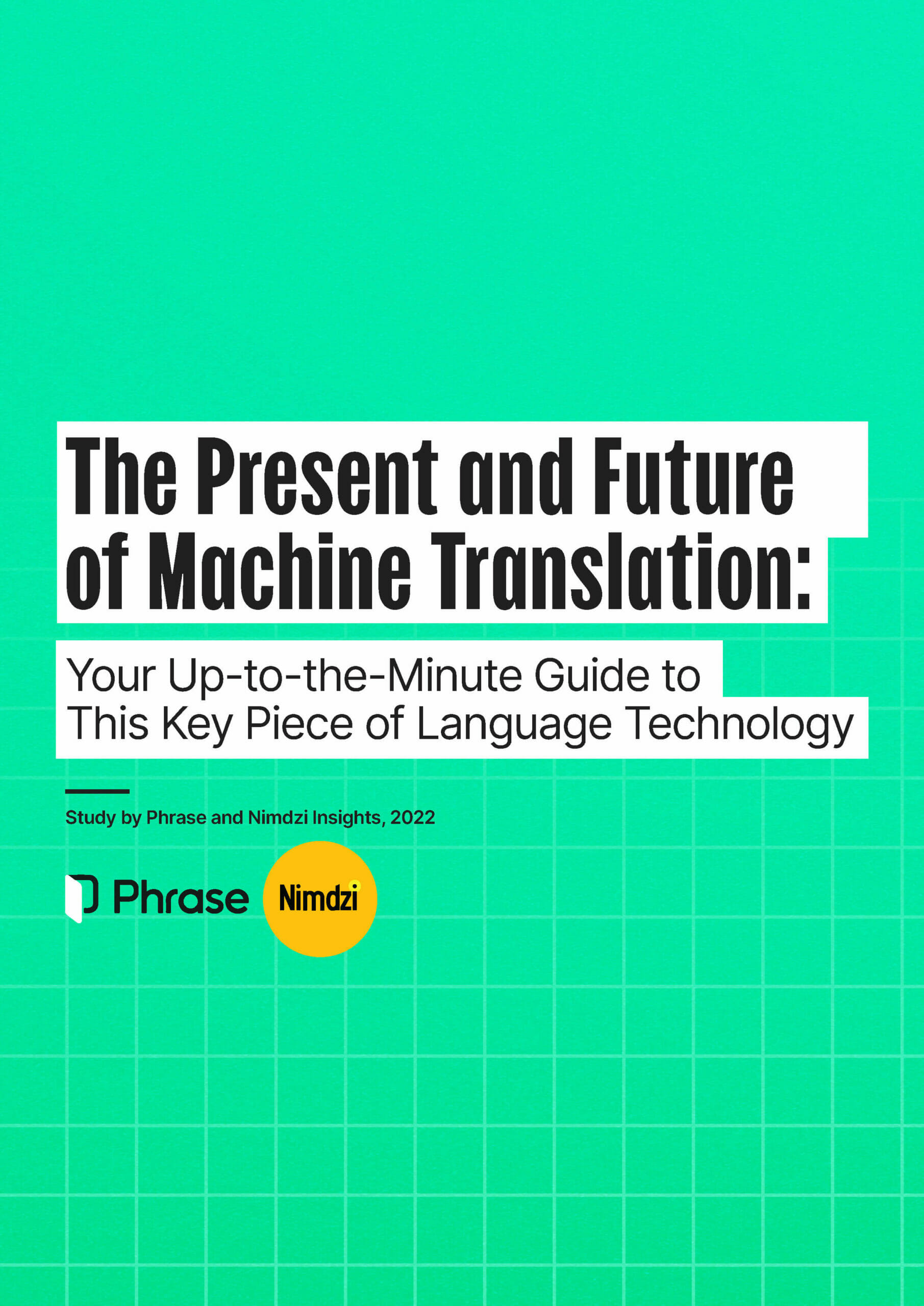Machine translation
Exploring DeepL for Machine Translation: How It Works, and How Accurate It Is

The promise to enable efficient and accurate communication across languages has been a driving force behind the development of machine translation (MT). What began as an experimental endeavor back in the 1950s—translation was one of the first applications of computing power—became a viable productivity tool in the 21st century.
Today, AI-driven machine translation tools are revolutionizing global business operations. One of the leading MT providers is DeepL, a neural machine translation (NMT) technology provider based in Germany. In this guide, we will explore how DeepL works, its pros and cons, and best practices for utilizing it in professional translation projects.
What is DeepL? A short overview
DeepL was founded in 2009 in Germany as Linguee, an online dictionary, which set out to create a neural machine translation system that could produce translations of a much higher quality than traditional statistical machine translation (SMT).
The engineers at DeepL applied the newest deep learning technique—hence the company’s name—to train the models on the existing data on Linguee’s database.
Since 2017, DeepL has become extremely popular—more than a billion people have used its services to date. It provides support for 28 languages, with 650 possible translation combinations.
Users can choose between the free and paid versions of DeepL, and between the web interface and the standalone translator. The free version is suitable for personal use, while the paid version offers more features for businesses.
DeepL is no longer just a translation service, though. It has now also had a go at artificial intelligence with a focus on text generation. Its newest offering, DeepL Write, launched in early 2023, seeks to become an English writing assistant and outperform rivals like Grammarly.

Download for free
Your up-to-the-minute guide to machine translation
Learn about new technologies to improve machine translation output quality, the latest on MT post-editing pricing models, and how to best shop for machine translation.
How does DeepL work?
Not all machine translation is created equal, and over time, systems have become more and more sophisticated. Until 2016, MT systems were either rule-based—which relied on numerous manually crafted rules—or statistical—which translated based on multilingual corpora (large bodies of parallel texts), in a word-based or phrase-based fashion, looking for statistical patterns.
Nowadays, most mainstream MT systems use neural networks. This is called neural machine translation, a form of end-to-end learning where the program’s neural network takes into account the whole input sentence at each step when generating the output sentence, rather than a few words on either side of the translated term.
DeepL is an example of an NMT system—thanks to deep learning algorithms, it produces translations that are more human-like than those generated by statistical MT engines. Its network architecture also enables it to learn from vast amounts of data and adapt to new contexts.
Analyzing DeepL’s features
As mentioned previously, DeepL’s core strength lies in its NMT system, enabling it to produce more accurate and natural-sounding translations compared to traditional statistical MT methods. Let’s take a look at some of its most prominent capabilities:
- Multiple language support: DeepL supports translations between a wide range of languages, including English, Spanish, French, German, Chinese, Japanese, and many more. Users can seamlessly translate text between different language pairs without the need for separate tools.
- Context awareness: The AI engine employed by DeepL can understand the context of the input text, aiming to ensure that the translations are more contextually accurate and maintain the intended meaning. This can be beneficial when dealing with idiomatic expressions and complex sentences.
- Translation quality: DeepL is known for its translation quality for certain language pairs, which is regarded highly by users. Its ability to grasp context and provide precise translations is valued by professionals and language enthusiasts alike.
- Translator plugin and desktop apps: DeepL offers browser plugins that can integrate with various applications, including Microsoft Office, facilitating direct text translation without leaving the program being used, or you can download its desktop app in the most popular operating systems.
- Document translation functionality: In addition to text translation, DeepL allows users to upload entire documents for translation, providing a useful feature for individuals and businesses working with multilingual content.
- Data privacy: Based in Germany, DeepL is subject to European Union data protection laws. While the company doesn’t say much about how data is handled in DeepL’s free machine translation tool, it makes it clear that all DeepL Pro subscribers can enjoy a secure and encrypted connection for all translations and that the data is not stored on their servers once the translation is completed.
- API Integration: DeepL offers an API that enables developers to integrate its translation services into their applications, websites, or services, providing a seamless translation experience for end-users.
What are DeepL’s major competitors?
The universe of machine translation tools is vast and varied. Aside from DeepL, some of the most well-known MT providers include:
Google Translate
Launched in 2006, Google Translate switched from a statistical model to an NMT one in 2016—a few months before DeepL launched.
It supports over 133 languages and is free to use (except for API usage to translate your own website or if you go over 500,000 characters per month). Its highly accessible interface and intuitive design make it a popular choice for casual users. Moreover, it can translate entire websites, images, and speech.
Systran Translate
Founded in 1968, Systran was the first commercial MT software on the market. Systran is also the only company with an open-source ecosystem for neural machine translation and neural sequence learning: OpenNMT.
Systran Translate supports over 50 languages, and users can add their own glossaries, dictionaries, and corpora to personalize the output.
Microsoft Translator
Integrated into Bing (Microsoft’s search engine) and as a built-in function in Microsoft Office applications, Microsoft Translator launched in 2009 and is based on the newest neural network technology with an attention-based model.
Nowadays, it’s also available as a standalone mobile app for both iPhones and Android devices. It supports over 100 languages and enables speech and text translation.
Amazon Translate
One of the youngest players in the field, Amazon Translate was released in 2017. It uses a neural machine translation engine and has achieved impressive performance levels in its short lifetime.
Users need an AWS account to access the range of functionalities that Amazon translate offers—customization (terminology and parallel data), encoding terminology, and batch translation (Amazon S3), to mention but a few.
Tencent Machine Translation
Tencent Machine Translation (TMT) is one of the newest entrants to the market. It currently supports 10 languages and combines both neural and statistical machine translation models.
Tencent Machine Translation is particularly notable for its Chinese-language capabilities, having obtained the highest recorded human evaluation scores for English-to-Chinese translation and the highest automated scores for Chinese-to-English translation.
DeepL vs Google Translate: Which is better?
Is DeepL better than Google Translate? The answer to this question, like anything else, depends on the context and the specific needs of the user. Generally speaking, DeepL is often seen as a more accurate MT engine than Google Translate.
That said, it does come with some limitations: DeepL’s language selection is more limited than Google’s, and to access its full range of features—like full document translation that retains the original formatting or the ability to choose between formal and informal register—you’ll need a premium account.
A feature that DeepL offers that users can’t get from Google Translate is the ability to click on any translated word in the output box to quickly view alternative translations. If you select a different translation from the one that DeepL has suggested, the rest of the text will automatically update to reflect your choice.
Security-wise, in the case of their free versions, both Google Translate and DeepL retain the history of the text you translate. DeepL Pro, by contrast, offers world-leading data protection standards and deletion of your texts immediately after translation. This makes it particularly suitable for sensitive content.
Overall, both providers offer useful solutions for machine translation. If you’re just looking for a cheap, easy-to-use translation tool with a wide range of language options that you don’t need to customize, then Google Translate may be the better option. On the other hand, if you need highly accurate translations that you can customize and need to be sure your data is protected, then DeepL is likely to be the better choice.
Evaluating DeepL’s accuracy and performance
Establishing the accuracy of a machine translation engine can be notoriously challenging. The results vary depending on the language pairs involved, the types of texts you’re translating—a highly technical financial document isn’t the same as a blog post—and the level of customization that you need.
Moreover, because language is dynamic and factors like the author’s intended meaning can’t be measured, accuracy takes on a relative definition. For example, the expectations of grammar and punctuation accuracy for a novel will differ from those for a social media post.
That said, based on general sentiment around the web, users report that DeepL tends to be quite accurate, especially when it comes to European language pairs. DeepL’s own experiments back this up. However, because the way the company presents the data could potentially be seen as biased, a more reliable indicator of accuracy is user feedback—which tends to be positive, mainly in terms of:
- Idioms and slang interpretation and equivalence
- Naturalness
- Register-sensitive translations
At the end of the day, each user will need to make their own decision after trying how DeepL performs in their use cases. The good news is that the free version allows you to do just that without incurring any cost.

Interactive MT report: Uncover top performers
Find out how leading machine translation engines perform for different content types using the latest data in our quarterly machine translation report.
The pros and cons of DeepL
Neural machine translation systems such as DeepL open up a whole world of possibilities. As one of the leading NMT technology vendors, DeepL can be:
- Fairly accurate: It can understand the broader context of words and phrases to produce more accurate and fluent translations and improve over time.
- Fast to learn: You can train neural networks quickly through automated processes, unlike the costly and largely manual methods required for conventional MT.
- Flexible and simple to integrate: Via APIs, extensions, and plugins, you can integrate it into most browsers or software, and apply it to many content file formats.
- Customizable: You’re usually able to customize DeepL‘s output through terminology databases, brand-specific glossaries, and other data sources to improve results.
- Cost-efficient: Like any other NMT engine, DeepL enables highly accurate and fast translations at a fraction of the cost.
- Scalable: When your translation needs to scale up, DeepL can help you meet increased demand easily.
That being said, even though DeepL’s development has reached great heights, hardly any machine translation engine will likely ever be perfect—and DeepL still has some way to go before catching up with human-level accuracy.
How much DeepL will continue to improve in the coming years remains to be seen and is difficult to predict. For now, it still falls short of human-level skills such as:
- Asking questions
- Understanding context
- Identifying errors in the source text
- Catching irony
- Translating creatively
- Making considered choices
- Doing research
- Observing consistency
- Guaranteeing completeness
- Deliberately leaving out or including information
- Adding glosses or notes
While the ability of machine translation engines to handle these types of tasks remains limited, manual post-editing is still likely to remain an essential part of any translation workflow in the near future.
Utilizing DeepL for professional translation: best practices
When using DeepL for machine translation, it’s important to stick to the use cases where you can get the most out of it without compromising on quality. These include:
- Low-visibility or low-traffic content, such as internal memos, website footers, emails, social media posts for sentiment analysis, etc.
- Repetitive technical content that only needs to be actionable, like instruction manuals—if possible, have a human translator post-edit this content to avoid any user experience issues.
- Low-risk content that doesn’t need to be completely accurate or follow complex regulations—a good example is user-generated content like product reviews, for which consumers generally don’t expect high quality.
- Quickly perishable content, like chat or email support messages, customer enquiries, etc.
- Large bulks of content with a short turn-around, such as hundreds of product descriptions that need to go live quickly.
- Frequently amended content—think feature and information updates.
Most of these use cases will require light machine translation post-editing (MTPE) to ensure accuracy and clarity, and you may even get away with using the raw output if the content is not mission-critical.
Some other types of content that require a higher level of accuracy will require more time-intensive post-editing. Among them, we find:
- Product titles: They are highly informative and concise, they tend to contain proper names and polysemous words, and their word order is usually relatively free, which can cause ambiguity.
- Translations between language pairs of dissimilar syntax: Japanese and Spanish, for example, involve a reordering of words and phrases that makes well-formed sentences more challenging for machine translation engines.
- Medium-visibility content that impacts customer experience: Knowledge bases, FAQs, alerts, etc. need to be as accurate as possible to fulfill the goal of efficient customer support.
- Back-end SEO meta information: Some SEO elements, such as image alt texts and captions, have low visibility but need technical optimization, e.g., target-language keywords, for improved search rankings.
How to make the most of DeepL with translation technology
Modern translation technology, such as localization platforms, has become an enabler of efficient global expansion efforts by revolutionizing the way enterprises manage, translate, and deliver multilingual content. These tools streamline the entire process from end to end.
Most of these solutions also integrate machine translation engines, allowing users to quickly convert large amounts of text into the target language within the same interface they already use to pull in, translate, review, and export content back to the system of origin. The gains in productivity alone are significant and, when combined with the cost savings associated with leveraging MT in the first place, the resulting ROI can be spectacular.
By contrast, when you use MT as a standalone engine that doesn’t live in the same system as your content, you’re effectively adding an extra layer of complexity to the translation process—just think of the hassle of manually uploading files or downloading results. The resulting bottlenecks, disjointed workflows, and lack of visibility into the entire process inevitably affect the delivery time and accuracy of your translations.
Take the case of DeepL as a fully managed MT engine in an enterprise translation management system such as Phrase TMS. The system automatically uses the best machine translation engine for each job, and its AI-based solution filters out content that shouldn’t be translated:
- There’s no need to worry about the technical setup: Simply toggling the switch to “on” will automatically enable the engine for your languages and allow you to start leveraging its power right away.
- Use DeepL only for the best-suited content: Although DeepL is a very powerful engine, there’s no guarantee—not all domains and language pairs will benefit from it in the same way. Phrase’s Autoselect feature allows you to enable multiple MT engines at once and assign them automatically to the content that best matches their capabilities.
- Leverage glossaries: You can manage all your machine translation glossaries and terminology directly in the TMS, and DeepL will use them to make sure all your translations are aligned with your company’s style. This works for other integrated MT engines too.
- Enjoy unlimited MT for post-editing across engines: Although DeepL offers unlimited MT as a standalone solution, with Phrase TMS, you can enjoy the same benefit for all fully managed engines.
DeepL is as good as how you use it
It’s clear that DeepL has come a long way since its humble beginnings, and today it can be used to quickly generate high-quality translations for a variety of use cases.
However, to unlock its true potential, you need to use it for the right kind of content, with differing levels of post-editing according to the use case, and of course, within the right technology. A translation management system such as Phrase TMS is the perfect context for this purpose, allowing you to access all the features that make DeepL shine.
Unlock the power of machine translation
Discover advanced machine translation management features within our enterprise-ready TMS and create new business opportunities worldwide more quickly and efficiently.





